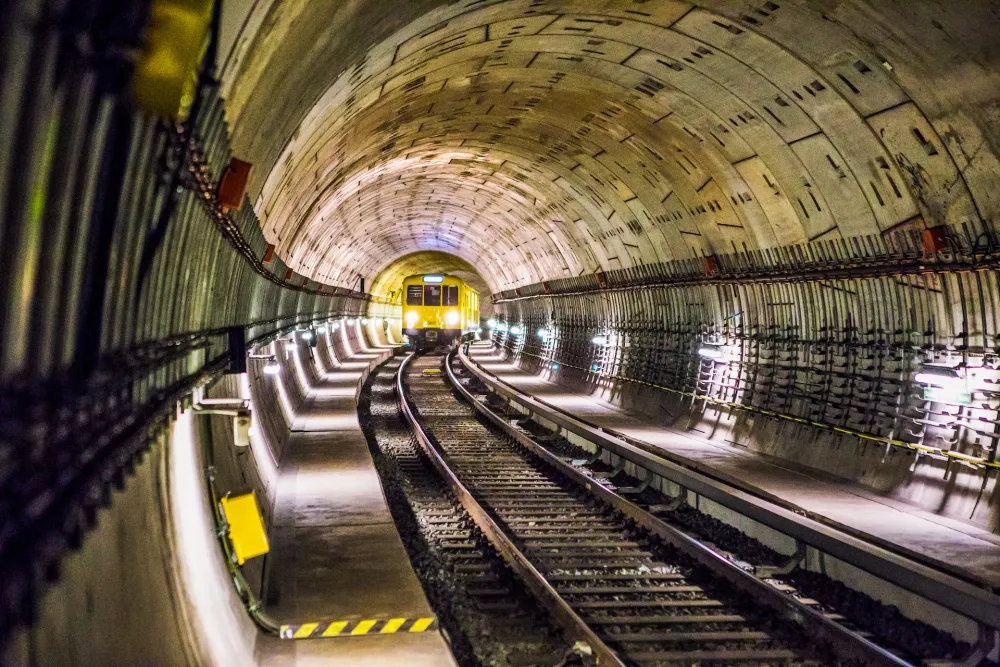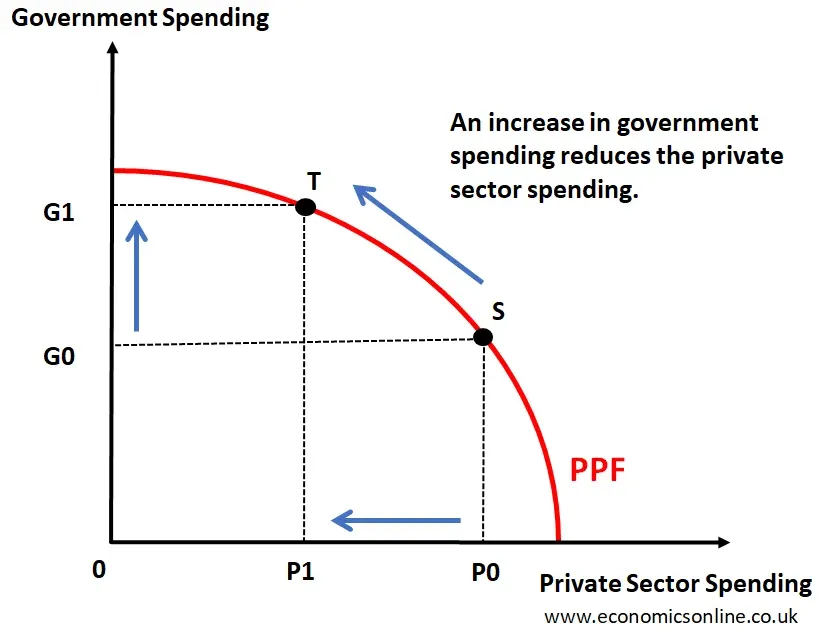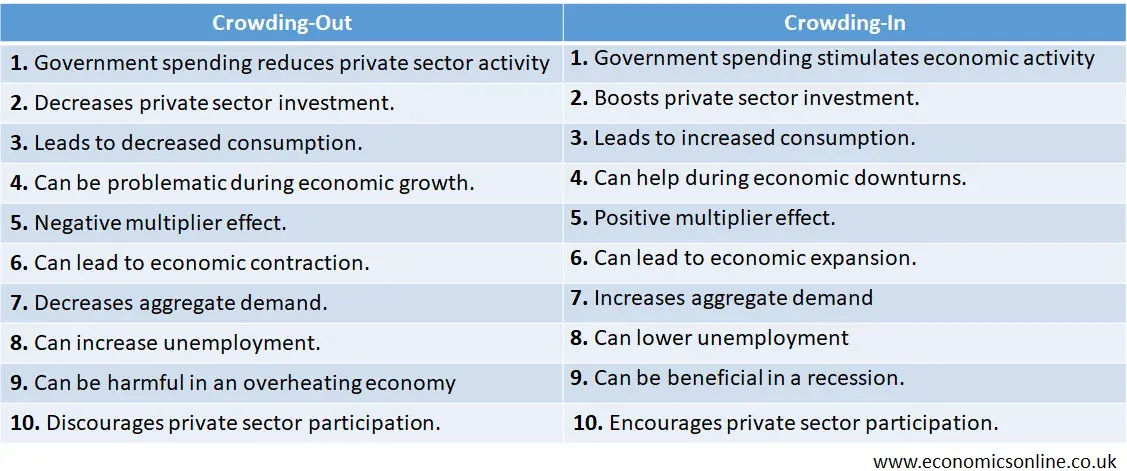
An image of a train on railway line as an example of infrastructure.
Crowding Out
What is Crowding Out?
Crowding out refers to an economic phenomenon where increased government spending reduces private sector investment.
Explanation
In economic theory, the crowding out effect refers to the decrease in private investment that occurs when the government increases its spending. This can happen because increased government spending, if financed by increased borrowing, leads to higher interest rates, making it more expensive for businesses and individuals to borrow money for investment. As a result, private investment may decline, potentially impacting economic growth and productivity.
On the other hand, if increased government spending is financed through higher taxes, private firms will again face a higher tax burden and ultimately reduce their private spending.
Example of Crowding Out
A real-life example of the crowding out effect can be seen during times of economic recession or crisis when the government implements expansionary fiscal policies to stimulate the economy. For instance, during the global financial crisis in 2008, many governments around the world increased their public sector spending on infrastructure projects and social welfare programmes to boost economic activity. However, this increased government spending led to higher interest rates and reduced access to credit for individuals and firms. As a result, private sector borrowing and investment decreased, limiting the potential for economic recovery.
Working of the Crowding Out Effect
The step-by-step working of the crowding-out effect is given below.
Step 1: A government increases borrowing or spending.
Step 2: This raises the demand for credit in the financial markets.
Step 3: An increased demand for credit leads to higher interest rates.
Step 4: Higher interest rates make borrowing more expensive for the private sector.
Step 5: The Private sector reduces borrowing for investments.
Step 6: Reduced private sector investment can hinder economic growth and job creation.
Types of Crowding Out
There are two major types of crowding out, which are given below.
Financial Crowding Out
This occurs when increased government borrowing leads to higher interest rates, reducing the availability of credit for private borrowers. As a result, private investment and consumption may decrease as individuals and firms face higher borrowing costs.
Example
An example of financial crowding out is when a government increases its borrowing to fund large infrastructure projects. This increased demand for borrowing can lead to higher interest rates in the economy. As a result, individuals and firms face higher borrowing costs, which can discourage consumption by individuals and investment by private investors. This decrease in private sector activity can offset the intended economic stimulus from the government's infrastructure spending.
Types of Financial Crowding Out
There are two types of financial crowding out.
Direct Crowding Out
This occurs when increased government borrowing directly competes with private borrowers for funds in the financial markets. As the government issues more government bonds to finance its spending, it increases the demand for credit, leading to higher interest rates. This makes it more expensive for individuals and firms to borrow, reducing their private consumption and investment.
Indirect Crowding Out
This happens when increased government borrowing indirectly affects private borrowing and investment through changes in monetary policy. When the government borrows more, it increases the money supply in the economy. To counteract inflationary pressures, the central bank may raise interest rates, making borrowing more expensive for everyone, including the private sector. This will reduce consumption by private individuals and investment by private sector firms.
Resource Crowding Out
This refers to a situation where increased government spending diverts resources away from the private sector. When the government expands its activities, it competes with the private sector for resources such as labor, capital, and materials. This can lead to higher costs for businesses and reduced productivity, potentially limiting private sector growth.
Example
An example of resource crowding out is when the government expands its public education system by hiring more teachers and building more schools. This increased government activity can lead to a higher demand for resources such as skilled teachers (labour) and construction materials. As a result, the private sector may face shortages of these resources, leading to higher costs and reduced productivity. This can limit private sector growth and investment as resources are diverted towards the government's education initiatives. This situation is also illustrated in the following graph.

In the above graph, the production possibility frontier (PPF) is shown. The private sector spending is taken on the horizontal axis (X-axis) and the government spending is taken on the vertical axis (Y-axis). At point S, government spending is G0 and private sector spending is P0. As government spending and private sector spending are inversely proportional, when the government moves from point S to point T on its production possibility frontier (PPF), the government spending increases from G0 to G1 and the private sector spending decreases from P0 to P1.
When does the Crowding Out Occur?
Crowding out can occur when there is increased government spending or borrowing. This can happen in various situations, such as during economic stimulus programmes, infrastructure projects, or when the government needs to finance budget deficits. When the government increases its spending or borrowing, it can lead to higher interest rates, reduced availability of credit, and increased competition for resources. This can crowd out private sector investment, consumption, and economic activity.
Crowding out can occur in various situations, such as
Expansionary Fiscal Policy
When a government increases its spending or reduces taxes to stimulate the economy, it may need to borrow more, leading to higher interest rates and crowding out private investment.
Infrastructure Projects
When a government undertakes large-scale infrastructure projects, it may require significant borrowing, which can increase interest rates and limit private sector borrowing and investment.
Budget Deficits
When a government runs budget deficits, it needs to borrow to finance its spending. This increased borrowing can lead to higher interest rates and crowd out private sector borrowing and investment.
Increased Government Debt
As a government accumulates more debt over time, it may need to borrow more, leading to higher interest rates and crowding out private sector borrowing and investment.
Is Crowding Out Good or Bad?
The crowding out effect is generally considered to have negative implications. It can hinder private sector investment and economic growth by increasing borrowing costs and limiting access to credit. However, it is important to note that in certain situations, such as during economic downturns or when there is a lack of private sector investment; government spending and borrowing can help stimulate the economy. So, the impact of crowding out can vary depending on the specific circumstances.
Crowding out vs. Crowding In
The following table summarises the main differences between crowding out and crowding in.

The Importance of Crowding Out
The concept and working of the crowding out helps us understand the potential consequences of increased government borrowing and spending.
It highlights the trade-offs between government spending and private sector borrowing and investment.
Understanding crowding out is important for economists and policymakers in making better economics decisions about fiscal and monetary policy.
It also helps assess the potential effects of government interventions on interest rates, private sector investment, and economic growth.
By recognizing the negative effects of crowding out, policymakers can strive to create a balance between government intervention and private sector activity for sustainable economic growth and stability.
Can Crowding Out affect Aggregate Demand?
Yes, crowding out can affect the aggregate demand. When an increased government borrowing increases interest rates, it can reduce private sector borrowing and investment leading to a decrease in aggregate demand.
The Effects of Government Policies on Crowding Out
Government policies can have a significant influence on crowding out.
Crowding out in Fiscal Policy
Expansionary fiscal policies, such as increased government spending or tax cuts, can lead to higher government borrowing, which may crowd out private sector investment by increasing interest rates and reducing available credit.
On the other hand, contractionary fiscal policies, such as reduced government spending or tax hikes, can help mitigate crowding out by reducing government borrowing and leaving more resources available for private sector investment. The specific design and implementation of government policies play a crucial role in determining the extent of crowding out effects on the economy.
Crowding Out in Monetary Policy
Government monetary policy can also impact crowding out. When the government implements expansionary monetary policy, such as lowering interest rates or increasing the money supply, it can encourage private sector borrowing and investment. This can help mitigate the crowding out effect by offsetting the potential increase in interest rates caused by government borrowing.
Conversely, a contractionary monetary policy, such as raising interest rates or reducing the money supply, can amplify the crowding out effect by making it more expensive for the private sector to borrow and invest. The coordination between fiscal and monetary policies is crucial in managing the potential crowding out effects and promoting a balanced economic environment.
Conclusion
In conclusion, crowding out is an important concept that helps us understand the potential consequences of increased government borrowing and spending. It highlights the trade-offs between government and private sector borrowing and investment. Government policies, both fiscal and monetary, can have a significant influence on crowding out. The design and implementation of these policies play an important role in determining the extent of crowding out effects on the economy. By recognizing and managing the potential negative effects of crowding out, policymakers can think of creating a balance between government intervention and private sector activity for sustainable economic growth and stability.


